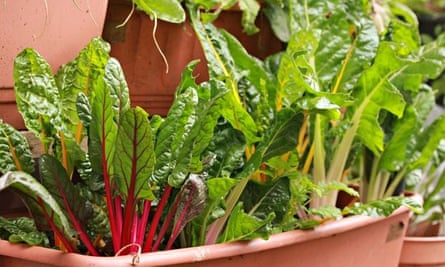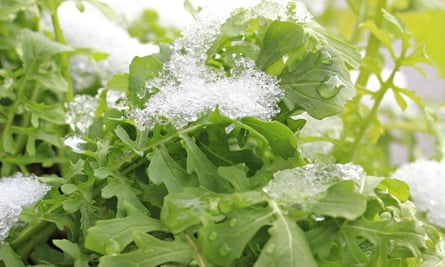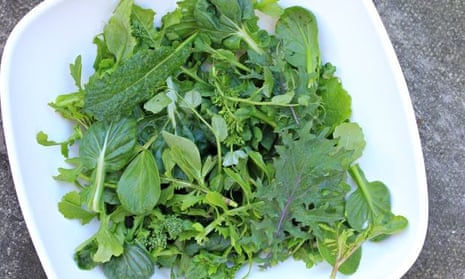Once you’ve plucked your last tomato of the summer or pulled out your final runner bean, it’s easy to imagine that the containers they filled are going to look rather sad as they sit bare and empty on the frozen wastes of your patio or windowsill over winter.
But you don’t have to leave them that way. There are many leafy crops that grow well over the cooler months, adding colour and cheer to your balcony or patio. And these crops don’t just look good, they taste great too. The most tasty salads I’ve ever eaten have been grown in my containers in February and March. There’s something about slow winter growth that results in leaves that sing with flavour.
There are three simple secrets to success with winter container growing: choosing the right crops to grow; sowing the seeds earlier enough (now for many of them); and protecting your crops from the wind as much as you can.
I urge you to give it a go. Although harvests are smaller than in summer, it’s good for the soul to be able to pick a few fresh leaves on a dark, dank winter’s day. It has other benefits too: by growing you are helping to maintain a living soil in your pots – neglected pots are prone to dry out and can be hard to re-wet.
So what can you grow? Although root crops like parsnips will grow in the ground in winter, in smaller spaces you’ll get a more worthwhile harvest by sticking to leafy crops for salads, stir fries, and steaming. A few herbs will grow well, too. Here are nine I recommend:
Rainbow or bright lights chard

Bright and beautiful in the container – and productive, tasty and versatile in the kitchen. Sow it by mid September at the latest and let the plants grow and get well established before it gets cold. You can start picking the outer leaves sparingly from mid November.
Winter purslane
This has a pleasing, slightly succulent texture and is rich in vitamin C. It grows well in the cold but less well in the wind – try and put it in a sheltered spot if you can.
Land cress
A strong, peppery leaf, reminiscent of watercress. Adding just a few leaves to a salad of shop bought lettuce will transform it into something really tasty. Sow it by mid September.
Cavelo nero
A variety of kale with leaves that look like tall plumes. It can make an impressive statement in your containers; give it a deepish pot (at least 20cm) and plenty of space (just two or three plants in a 40cm x 40cm container) if you want it to grow to a decent size. Ideally it is best sown in July to give it time to grow into a good size plant, but you still have just enough time to sow it now, particularly if you are in the south of the UK. This is a delicious leaf cooked or in salads – and like other kales has a reputation as a superfood too. It tastes even better after a hard frost.
Rocket

Less prone to bolt over winter than it is in summer, and so delicious, particularly when grown in winter. Sow before the end of September.
Sorrel
A delicous, lemony leaf – just a few leaves will add a zip to any winter salad. Sow by mid September.
Mustards
Easy to grow, and full of flavour. There are many varieties, like mizuna and mustard red frills – buying a pack of mixed mustard seeds is a good way to find which you like. Sow by the end of September.
Coriander
I was surprised to discover that this is easier to grow in the autumn and winter than it is in summer. What’s more, the smell and taste of home-grown coriander in winter is in a league of its own. Sow it by mid September, pick sparingly from mid November, and it will regrow strongly in early spring. Winter growing expert Charles Dowding recommends the herbs chervil and dill are good to sow now, too.
Tatsoi
Closely related to pak choi, but tastier and more attractive, I think. Great in salads. Sow by the end of September.
Here are some tips to help you grow successfully in winter:
1. Your crops need to be well established by November so that they will survive cold weather when it comes – sowing them by the times mentioned above is important. Start them in seed trays or modules if your pots are still full of tomatoes or beans.
2. Even in winter, containers need watering, particularly in dry winters or if your containers are in the shadow of a wall. But they’ll need a lot less watering than they do in summer. Check the moisture regularly by putting your fingers a couple of inches into the compost. It should feel like a well rung out flannel. Avoid watering before freezing weather is predicted: you don’t want the water to freeze in the pot.
3. Crops in winter grow more slowly and so need less feeding than in summer. If you are using new compost, they will need little if any feed until the spring. If you are using old compost, mix in a good dose (15-20%) of worm compost if you have it, or a handful or two of chicken manure pellets if not. Feed with liquid seaweed or worm tea once the weather begins to warm up (March or April) and when the plants start grow vigorously again.
4. Put your plants in the most sheltered spots you can. Although many will survive without protection, they will grow more strongly and be more productive if you cover them with a fleece or a cloche of some sort. You can buy these online or in garden centres, but I make cloches out of old hoola hoops or plumbers piping and cover them with transparent plastic I found in a skip.
5. Harvest the outer leaves of your crops by picking or cutting them off. Leave plenty of the inner leaves for the plant to regrow, particularly in the colder months. Growth will slow right down over winter, particularly in colder years, but the plant will regrow with vigour in the early spring. Indeed, the early spring harvests are the most rewarding part of growing this way.
Mark is Founder of Vertical Veg a social enterprise that inspires and supports food growing in containers in small spaces. For free, seasonal container growing tips, sign up to his newsletter at www.verticalveg.org.uk.
Interested in finding out more about how you can live better? Take a look at this month’s Live Better challenge here.
The Live Better Challenge is funded by Unilever; its focus is sustainable living. All content is editorially independent except for pieces labelled advertisement feature. Find out more here.

Comments (…)
Sign in or create your Guardian account to join the discussion